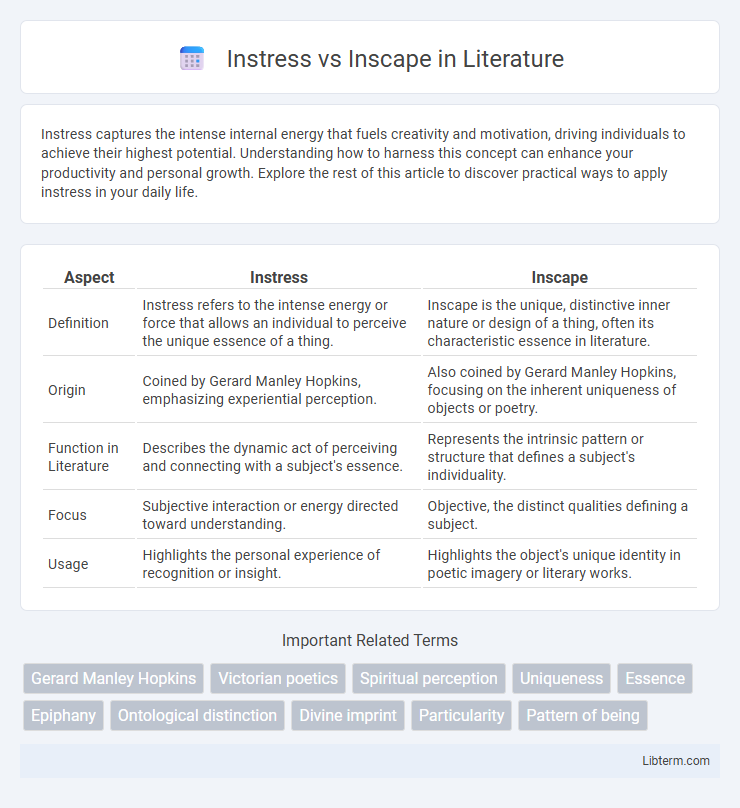Instress captures the intense internal energy that fuels creativity and motivation, driving individuals to achieve their highest potential. Understanding how to harness this concept can enhance your productivity and personal growth. Explore the rest of this article to discover practical ways to apply instress in your daily life.
Table of Comparison
| Aspect | Instress | Inscape |
|---|---|---|
| Definition | Instress refers to the intense energy or force that allows an individual to perceive the unique essence of a thing. | Inscape is the unique, distinctive inner nature or design of a thing, often its characteristic essence in literature. |
| Origin | Coined by Gerard Manley Hopkins, emphasizing experiential perception. | Also coined by Gerard Manley Hopkins, focusing on the inherent uniqueness of objects or poetry. |
| Function in Literature | Describes the dynamic act of perceiving and connecting with a subject's essence. | Represents the intrinsic pattern or structure that defines a subject's individuality. |
| Focus | Subjective interaction or energy directed toward understanding. | Objective, the distinct qualities defining a subject. |
| Usage | Highlights the personal experience of recognition or insight. | Highlights the object's unique identity in poetic imagery or literary works. |
Introduction to Instress and Inscape
Instress and Inscape are interconnected concepts in literary theory and philosophy, primarily introduced by British poet and critic Gerard Manley Hopkins. Inscape refers to the unique, intrinsic design or essence of an object or being, capturing its distinctive individuality, while Instress is the force or energy required to perceive and appreciate that unique essence. Understanding Instress involves recognizing the intense internal energy that connects the observer to the object's Inscape, emphasizing the dynamic relationship between perception and identity.
Defining Instress: Meaning and Origins
Instress refers to the unique energy or force within an object or experience that compels an individual to recognize its distinctiveness, originally coined by poet Gerard Manley Hopkins. It embodies the internal perception and emotional response triggered by the object's intrinsic qualities. Instress contrasts with inscape, which describes the object's inherent design or unique essence that defines its identity.
Understanding Inscape: Concept and Context
Inscape refers to the unique inner nature or essence of an object, concept, or experience, emphasizing its distinctive characteristics and intrinsic qualities. Originating from the work of poet Gerard Manley Hopkins, inscape captures the specific design or pattern that defines the individuality of a subject in both literature and philosophy. Understanding inscape involves recognizing the deep, often spiritual, interconnectedness of form and meaning within a given context, highlighting the singular identity that sets it apart from others.
Gerard Manley Hopkins: The Architect of Instress and Inscape
Gerard Manley Hopkins pioneered the concepts of Instress and Inscape, critical to his poetic philosophy emphasizing the unique essence of individual objects. Inscape defines the distinct, intrinsic design or pattern of an entity, capturing its unique identity, while Instress represents the dynamic energy or force required to perceive and appreciate this uniqueness. Hopkins' innovative interplay of these ideas transformed Victorian poetry by infusing it with a spiritual intensity and heightened sensory awareness.
Instress vs Inscape: Key Differences
Instress and Inscape represent distinct concepts in literary and psychological contexts, with Instress referring to the intense energy or force exerted by an object or idea that allows a person to perceive its unique essence, while Inscape denotes the inherent, individual design or distinctive pattern that defines something's true nature. Instress is the dynamic experience or recognition process of an object's Inscape, emphasizing how one perceives and internalizes its uniqueness. The key difference lies in Instress being the active perception and emotional engagement, whereas Inscape is the static intrinsic quality or identity of the subject itself.
The Role of Instress in Perception
Instress, a term coined by poet Gerard Manley Hopkins, refers to the intense energy that allows an individual to perceive and internalize the unique essence of an object or experience. This dynamic force bridges the external reality (Inscape) with personal perception, making each encounter deeply subjective and vivid. By activating Instress, one apprehends the distinctive structure and inner nature of phenomena, enhancing empathic understanding and aesthetic appreciation.
Inscape and the Uniqueness of Objects
Inscape refers to the unique inner nature or essence of an object, highlighting its distinct characteristics that differentiate it from others. This concept underscores the individuality and intrinsic qualities that define an object's identity in a meaningful way. Instress, by contrast, is the force or energy that perceives and conveys this uniqueness, enabling the recognition and appreciation of the inscape in objects.
Literary Examples: Instress and Inscape in Poetry
Instress and inscape are key concepts in poetry, famously explored by Gerard Manley Hopkins. Inscape refers to the unique inner nature or essence of a thing as revealed through detailed, vivid description, while instress is the force or energy that drives the poet to perceive and express that distinctiveness. For example, Hopkins' poem "The Windhover" exemplifies inscape through its intricate depiction of a falcon's flight, with instress evident in the passionate intensity that brings this vision to life.
Impact of Instress and Inscape on Modern Criticism
Instress and inscape, concepts introduced by poet Gerard Manley Hopkins, significantly influence modern literary criticism by emphasizing the unique essence and energy of individual subjects. Instress refers to the dynamic force that enables perception of inscape, the distinctive design that defines an object's intrinsic nature, shaping critical focus on authenticity and nuanced textual interpretation. These ideas promote a deeper appreciation of subjective experience and ontological depth, enriching contemporary analytical frameworks in poetry and prose.
Conclusion: Enduring Relevance of Instress and Inscape
Instress and Inscape remain vital concepts in literary and philosophical studies, embodying the deep connection between external realities and individual perception. Instress captures the dynamic force allowing one to grasp the essence of an object, while Inscape represents the unique inner pattern or identity of that object. Their enduring relevance lies in how they continue to inform contemporary analyses of aesthetics, cognition, and the nature of experience.
Instress Infographic

 libterm.com
libterm.com